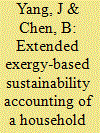|
|
|
Sort Order |
|
|
|
Items / Page
|
|
|
|
|
|
|
| Srl | Item |
| 1 |
ID:
176695


|
|
|
|
|
| Summary/Abstract |
There are overwhelming proofs that world-wide carbon emission profiles have been substantially shaped by carbon leakage through international trade. However, it has been unclear how structure and functions of the global carbon transfers evolve in terms of a complex network. Therefore, this study applies a series of network tools to depict the evolution features of the global carbon flow network from 1995 to 2011 as supported by a systems multi-regional input-output analysis. At global level, the network density increases essentially, indicating the widely expanding carbon leakages among economies. The increasingly distinct scale-free distribution for cumulative degree/weighted degree implies the network's intensified heterogeneity structure. At regional level, a new tripartite cluster structure has been identified by the three gradually stabilized communities centered on USA, China and Europe. At national level, the evolution for all economies' roles, especially two prominent groups (i.e. G8 and BRICS), is enunciated by coreness in context of the core-periphery structure, highlighting the significance of monitoring core economies' carbon emission flows. The results urge the need to shift from local carbon mitigation in silos to global collective and inclusive governance. Regional cluster structure's identification highlights the urgency for multinational cooperation on emission mitigation within the three newly formulated communities.
|
|
|
|
|
|
|
|
|
|
|
|
|
|
|
|
| 2 |
ID:
018286


|
|
|
|
|
| Publication |
2000.
|
| Description |
1-15
|
|
|
|
|
|
|
|
|
|
|
|
|
|
|
|
| 3 |
ID:
133144


|
|
|
|
|
| Publication |
2014.
|
| Summary/Abstract |
Biogas has been earmarked as one of the leading renewable energy sources capable of mitigating environmental emissions in rural areas. Thus, developing an accounting technique is of particular importance in coping with increasing problems related to renewable agriculture and rural energy supply. In this study, extended exergy was generalised for the sustainability evaluation of biogas projects. Furthermore, a series of extended exergy-based indicators was presented as benchmarking from the perspectives of resources, economics and greenhouse gas (GHG) emissions. The sustainability of a "Three-in-One" biogas production system in southern China was thereby evaluated based on the proposed framework. The results show that economic costs concentrate in the construction phase. GHG emissions are mainly derived from bricks and cement, with proportions of 36.23% and 34.91%, respectively. The largest resource depletion occurs during the consumption of feedstock (87.06%) in the operation phase. Compared with other renewable energy conversion systems, the biogas project has a higher renewability (0.925) and economic return on investment ratio (6.82) and a lower GHG emission intensity (0.012). With the merit of bridging thermodynamics and externality, the extended exergy-based approach presented in this study may effectively appraise the energy and environmental performance of biogas projects.
|
|
|
|
|
|
|
|
|
|
|
|
|
|
|
|
| 4 |
ID:
125647


|
|
|
|
|
| Publication |
2013.
|
| Summary/Abstract |
The carbon emission embodied in trade is fundamental for allocation of responsibility between producers and consumers. This paper quantitatively analyzes embodied carbon emissions along the life cycle of electricity supply, based on network theory. A modified carbon emission flow model is established, based on life cycle assessment considering power losses. There is also a case study of China's interregional electricity supply system in 2010, focusing on two carbon emission carriers, electricity coal transportation and electricity transmission. Results show that the total carbon emission flow reached 169.355 MtCO2eq, i.e., 4.67% of the life cycle carbon emission. Of this, 61.1% was carried by electricity coal transportation before power generation and transmission, owing to an uneven distribution of coal resources. The eastern and southern regions are the major net sinks of carbon emission flows, representing 52.9% and 27.8% of the total, respectively, because of their enormous energy imports. In contrast, the Sanxi region and central China are major net sources of carbon emission flow. The proposed model may help allocate environmental responsibility among different regions, to guarantee balanced trans-regional development.
|
|
|
|
|
|
|
|
|
|
|
|
|
|
|
|
| 5 |
ID:
094246


|
|
|
|
|
| Publication |
2010, 2010.
|
| Summary/Abstract |
A unified evaluation integrating various forms of energy sources and natural resources, products and services, and imports and exports is carried out systematically at the national scale for the booming Chinese economy 1978-2005, based on the ecological measure of solar emergy. The development of the economy is shown heavily dependent on the consumption of nonrenewable natural resources. Of the total resources use, the indigenous resources contribute the most, along with the increasing imports of nonrenewable resources. The development of the Chinese economy is characterized with the recovery stage during 1978-1981, transformation stage during 1981-1991, steady growth stage during 1991-2000, and accelerated increase stage after 2000, with specific distinctive systems indications.
|
|
|
|
|
|
|
|
|
|
|
|
|
|
|
|
|
|
|
|
|